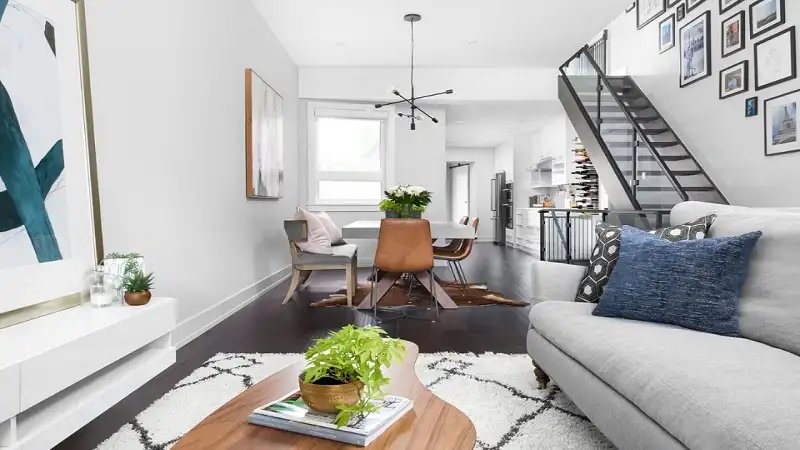Living in a small space comes with unique challenges. Whether you’re in a compact apartment, a studio, or just trying to make the most out of a single room, the feeling of being confined can be frustrating. But here’s the good news: with the right strategies, you can make your small area look and feel much bigger than it actually is. By using smart design choices, clever storage solutions, and visual tricks, you can create an environment that feels open, airy, and comfortable.
Below, we’ll explore practical techniques under different categories so you can transform your small space into one that looks spacious, stylish, and functional.
Use Light Colors to Brighten the Room
The color palette of your space has a dramatic impact on how big it feels. Dark shades tend to absorb light, making walls feel closer and the room smaller. On the other hand, light colors reflect natural and artificial light, which helps create an airy, open atmosphere.
- Walls: Stick with whites, creams, light grays, or pastels. These shades visually push the walls back, giving the impression of more space.
- Ceilings: Painting your ceiling a lighter color than your walls draws the eye upward, making the room feel taller.
- Furniture and Décor: Opt for lighter-toned furniture or choose translucent materials like glass or acrylic to prevent visual heaviness.
Light colors don’t have to feel bland. Add subtle textures, patterned rugs, or light-colored throw pillows to keep the room interesting without overwhelming it.
Incorporate Mirrors for Visual Expansion
Mirrors are one of the most powerful tools for creating the illusion of more space. They reflect light and give the perception of added depth, instantly making a room feel larger.
- Full-Length Mirrors: Lean or mount a tall mirror against the wall to elongate vertical space.
- Mirror Panels: A mirrored wall or strategically placed panels can make a narrow room look wider.
- Decorative Mirrors: Instead of artwork, hang multiple small mirrors in a design arrangement to bounce light around.
When placed opposite windows, mirrors reflect outdoor views, almost tricking the eye into believing there’s another opening in the room.
Choose Furniture with Multiple Functions
In small spaces, every piece of furniture should serve more than one purpose. Multi-functional furniture reduces clutter and frees up floor area.
- Sofa Beds: Ideal for studios or one-room apartments, they serve as seating by day and a bed by night.
- Ottomans with Storage: Use them as extra seating, a coffee table, and hidden storage all at once.
- Foldable Tables: Dining or work tables that can fold down against the wall save significant space.
- Storage Beds: Beds with built-in drawers eliminate the need for bulky dressers.
By keeping furniture versatile, you maximize usability without crowding your small area.
Maximize Vertical Space
Small rooms often lack floor space, but vertical areas usually go underutilized. By building upward, you create storage and design elements without sacrificing square footage.
- Tall Bookshelves: Use floor-to-ceiling shelves to store books, décor, and essentials.
- Wall-Mounted Cabinets: Free up floor space by attaching cabinets and shelves directly to the wall.
- Hanging Storage: Hooks, pegboards, and wall racks keep items like coats, kitchen utensils, or tools off the floor.
- Loft Beds: In very tight quarters, a loft bed opens up space underneath for a desk or seating.
Making use of vertical space draws the eye upward, which contributes to a more spacious feel.
Keep It Minimal and Declutter Regularly
Clutter is the number one culprit for making a small space feel cramped. Too many items crowd the eye and shrink the room visually.
- Adopt Minimalism: Keep only the items you use or truly love.
- Storage Solutions: Use baskets, bins, and organizers to keep smaller items tucked away.
- Declutter Habits: Set aside time monthly to get rid of unused clothing, papers, or random objects.
Remember, less is more in small spaces. A few statement pieces are far better than filling every surface with objects.
Create Zones within the Space
Even in small areas, defining zones helps organize the layout and prevents the room from feeling chaotic. It also makes the area feel more intentional and therefore larger.
- Rugs: Use different rugs to visually separate a seating area from a workspace.
- Lighting: Place floor lamps or pendant lights to highlight certain areas.
- Furniture Placement: Arrange furniture to create natural boundaries, such as using a sofa to separate the living area from the dining nook.
When each part of the room serves a clear function, the space feels structured and spacious rather than cluttered.
Let in Natural Light
Nothing makes a room feel larger than sunlight. Bright, natural light opens up any space and makes it feel welcoming.
- Curtains: Use sheer, light-colored curtains or avoid them altogether to maximize light.
- Blinds: Choose slim, minimal blinds that don’t block window openings.
- Window Placement: Keep furniture away from windows so they remain unobstructed.
If natural light is limited, invest in layered artificial lighting, such as ceiling lights, wall sconces, and lamps, to brighten every corner.
Opt for Clear and Reflective Materials
Transparent and reflective surfaces create a sense of openness by minimizing visual barriers.
- Glass Tables: Unlike solid wood tables, glass tops allow light to pass through, keeping the floor visible.
- Lucite or Acrylic Chairs: They provide seating without adding bulk.
- Glossy Finishes: Reflective cabinets, glossy tiles, and polished metals bounce light, helping the room feel brighter and more expansive.
These subtle touches ensure furniture blends into the space instead of dominating it.
Use Smart Storage Solutions
Efficient storage is the backbone of a functional small area. The goal is to store more without making the room feel cramped.
- Under-Bed Storage: Utilize bins, drawers, or vacuum-sealed bags under the bed.
- Built-In Shelves: Integrate storage into walls to save square footage.
- Hidden Compartments: Coffee tables, benches, and headboards with storage keep belongings out of sight.
- Over-Door Organizers: Perfect for shoes, accessories, or bathroom essentials.
When everything has a designated place, your space automatically looks bigger and tidier.
Choose the Right Furniture Scale
Oversized furniture can overwhelm a small room. Instead, choose pieces that fit the proportions of your space.
- Compact Sofas: Opt for loveseats or apartment-sized couches rather than bulky sectionals.
- Slim Profiles: Chairs and tables with thin legs appear lighter and less imposing.
- Low Furniture: Pieces with lower profiles make ceilings feel taller.
The right scale ensures that your furniture complements the room rather than crowds it.
Add Vertical Stripes and Patterns
Patterns can also trick the eye into perceiving more space. Vertical stripes, for instance, elongate the room and make ceilings appear higher.
- Wallpaper: Apply striped or subtle patterned wallpaper on one wall to draw the eye upward.
- Rugs: Long, linear rugs visually stretch the floor space.
- Curtains: Vertical-striped curtains emphasize height.
Use patterns sparingly so they don’t overwhelm the area but strategically enough to expand the perception of space.
Keep Pathways Clear
One overlooked aspect of small spaces is movement flow. If walking paths are blocked by furniture, the room feels tight and uncomfortable.
- Floating Furniture: Pull sofas and chairs slightly away from walls to create breathing room.
- Minimal Obstacles: Avoid placing items in direct walking paths.
- Open Corners: Keep at least one or two corners open to avoid a boxy feel.
By maintaining easy circulation, you make your space feel not only bigger but also more welcoming.
Conclusion
Living in a small space doesn’t mean sacrificing comfort or style. By applying the right design tricks—like using light colors, mirrors, multi-functional furniture, and smart storage—you can completely transform your environment. Remember, the illusion of space isn’t just about visuals; it’s also about how a room functions. When your space is bright, clutter-free, and well-arranged, it naturally feels more open.
With these techniques, your small area can feel not only larger but also more stylish, functional, and inviting.

